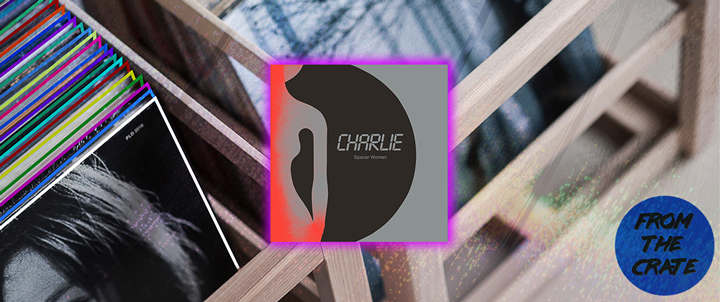Charlie “Spacer Woman”
The birth of our underground brand Factory 93 not only brought on an adrenaline rush reminiscent of the renegade warehouse era of raving—on which Insomniac was founded—but it also had us thinking back to all the people, places and parties that made this whole operation possible. And with that came a burning desire to crack open our collection and dust off the classic records we couldn’t live without. Through our From the Crates series, we’ll be breaking out both seminal and obscure cuts alike, imparting some knowledge in the process.

Charlie’s “Spacer Woman” is one of the greatest dance 12″s of all time, and it’s sort of—at least in a technical sense—a one-hit wonder. If you’re unfamiliar, please give it a spin.
This record came out in 1983, smack in the middle of one of music’s—especially 4/4 dance music’s—most fertile periods, as the fumes of disco were paving the way for electro, hip-hop, and Italo disco, as well as other synth- and drum-machine-led formats.
Maurice Cavalieri, who produced and arranged “Spacer Woman,” co-wrote it with Giorgio Stefani, a fellow member in the Italian disco group Firefly. That outfit had released a variety of jams in the early ‘80s as disco started to sundown. Together, they wrote breezy, inviting roller jams like “Love (Is Gonna Be on Your Side),” “Do It Dancin,” and “Love and Friendship.”
Their tastes moved from fluffier, more maximalist disco fare to the steely timbres of what you find on the “Spacer Woman” record. Cavalieri was inspired by emerging new wave artists, like Depeche Mode and Heaven 17, who were really embracing synthesizers as the leading sound—and not just a supporting instrument—in creating futuristic soundscapes. Unlike Firefly, Charlie was cold, alien, and sharp. Cavalieri wanted to move away from the lovey-dovey and shoot for something much more melodramatic.
Cavalieri enlisted Stefani to help him compose both the tune and the lyrics. Historically, a lot of Italo disco records have suffered from poor songwriting and/or poor English translation. Sometimes, the clunky lyrics make an Italo disco song more endearing to English-speaking audiences, though that’s probably the exception to the rule.
“Spacer Woman” feels like a melancholy take on Kraftwerkian motorik precision, like a robot that is somehow aware of humans and its own limitations.”
With “Spacer Woman,” however, the sparse, simple lyrics feel poetic and perfectly placed:
I’m a Spacer Woman
Don’t you worry ‘bout me
I don’t want to hurt you
I just want to love you!
We can start it over
Come on, be my lover
You will be my danger
Let me be your stranger!
It appears to be a story told from the Spacer Woman—some extraterrestrial or celestial, feminine being who is trying to seduce our earth-based listener. It’s unclear if “Spacer” is a mistranslation or an intentional choice. Either way, the track’s vocal really pushed it over the edge to make it one of the genre’s finest and most enduring.
Recorded in Vincenza, Italy, “Spacer Woman” feels like a melancholy take on Kraftwerkian motorik precision, like a robot that is somehow aware of humans and its own limitations. The drum machine and synths give it a punchy, space-shuttle propulsion (even though they might seem quaint by modern standards), and lilting synthlines make the song feel introspective.
“Spacer Woman” was released as a 12″ on Cavalieri’s own label, Mr. Disc Organization (also the home to the Firefly releases and a ton of other records in the early ‘80s) in 1983. The following year, German label XYZ—who’s often credited with coining the phrase “Italo disco” in the first place—re-pressed and released “Spacer Woman.” But this would be the only release to come out under the Charlie name.
Stefani and Cavalieri put out another Italo classic, International Music System’s “Run Away,” in 1983 (as well as an excellent LP). It was another brittle classic that hits dancefloor-friendly but bittersweet notes similar to “Spacer Woman.”
It’s not clear how many records of “Spacer Woman” were sold, or if it ever charted well in Europe, but over a longer period of time, the record has been purchased and played probably millions of times. Somehow, the track has stayed relevant among a sea of amazing records from that era, largely in part to a Dutchman.
“Spacer Woman” returned to dancefloor and cultural prominence in 2000 with the release of I-F’s legendary 2000 mix Mixed Up in the Hague Vol. 1. Widely considered one of the most influential mixtapes ever, the Dutch DJ’s megamix helped make a lot early-‘80s music feel fresh and relevant again. It was a series of underground Italo classics sequenced with some American dance tunes and a handful of contemporary Italo and electro cuts from Hague producers, but it feels like a giant love letter to Italo and all this proto-house machine music that had probably felt quite forgotten by the end of the ‘90s.
It also introduced sleeper classics—like “Spacer Woman,” Mr. Flagio’s “Take a Chance,” and proto-techno jam “Shari Vari” by Number of Names—to a whole new generation of DJs, producers, and dancers. Mixed Up in the Hague is a bona fide classic in its own right and (full disclosure) was this writer’s first exposure to the track, as well.
Perhaps, because DJs like I-F kept “Spacer Woman” in rotation around the turn of the century, it also figured heavily in various synth-led vocal acts throughout the chaotic MP3-driven decade of the ‘00s. You could feel the influence of “Spacer Woman” hanging over much of the bloghouse-adjacent Italo renaissance of the ‘00s, with acts like Lovelock, the artists of Italians Do It Better (Farah, Desire, Glass Candy, et al), and Norway’s Sally Shapiro all dancing around this glassy warmness—or inviting iciness—that Charlie so purely captured.
In fact, many cite Mixed Up in the Hague Vol. 1 as the catalyst for the Italo renaissance and one of the reasons why Italo is so warmly embraced by millennial audiences and dancefloors today.
I-F followed Hague years later with a sequel, Mixed Up in the Hague Vol. 2, which included the International Music System track “Nonline.” Some believe this second version eclipses the original. They’re both essential listening, and basically every track on these two mixes is like “Spacer Woman”: a gem worthy of discovery.



